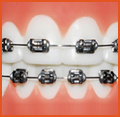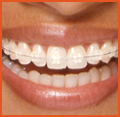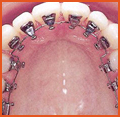
Orthodontics is the branch of dentistry that specializes in the diagnosis, prevention and treatment of dental and facial irregularities.
Types of Braces :
Metal Braces :

Metal Braces Conventional metal braces are most common and still widely used braces treatment. They give the same result when compared to other types of braces but the only disadvantage is that they are unaesthetic.
Clear | Ceramic Braces


Clear braces makes wearing braces less noticeable and hence, look aesthetic. They can be combined with vibrant colored elastic giving you a fancy look. These are braces which commonly people prefer.
Lingual | Invisible Braces

Lingual braces are attached to the inside or lingual side of the teeth which makes them completely invisible. Lingual orthodontics particularly well-suited for adults whose profession keeps them in the public eyes such as actors, models, etc.
We treat children and adults with
When would one need orthodontic treatment?
Ans.: Teeth are important for chewing food properly, for good appearance and for proper speech. If any one or more of these functions of teeth are adversely affected due to irregular teeth and/or jaws, one would need orthodontic treatment.
When teeth of the upper and the lower jaws do not meet properly with each other grinding of food properly is impaired. This may cause indigestion and related health problems.
When teeth are projecting out, lips are not closing normally, or teeth are crowded and are spoiling the smile, one needs orthodontic treatment for aesthetic reasons.
One may need orthodontic treatment to correct discrepancies in jaw size and/or positions, which affect the facial appearance adversely. When the jaws and/or teeth do not meet properly with each other, excessive forces may be transmitted to some teeth leading to wearing out of the enamel of the teeth. Excessive forces may also cause damage to the tooth supporting structures like the gums and surrounding bone. This can cause weakening and early loss of these teeth.
Irregular teeth can also cause difficulty in brushing thereby leading to cavities and gum problems which may shorten the life of the affected teeth.
In rare cases irregularities like spacing in the front teeth can cause speech problems and orthodontic treatment can improve the speech as well.
How important is orthodontic treatment?
Ans.: In today's world good appearance and a good smile go a long way in making a person feel confident and comfortable with one's self.
People with good looks and a pleasant smile are perceived well by others and are treated favourably by them.
Good-looking children are subconsciously liked more by parents, teachers and other adults.
Good-looking adults are more likely to get good jobs, more friends and better life partners.
So, the value of orthodontic treatment cannot be overemphasized. It is a question of a child's or an adult's future physical and psychological well-being.
When should a child go for an orthodontic consultation?
Ans.: It is recommended that the first check up by an orthodontist should be done by 6 years of age. If a dental or jaw problem is developing it can be corrected as the child grows. If the teeth and the jaws are developing normally then a regular check up should be done every six months to monitor the development.
In case the lower jaw is growing excessively, it must be corrected at the earliest because this condition becomes more difficult to treat as the child grows. Some conditions can be treated later. Certain teeth irregularities can be corrected earlier thereby preventing them from becoming more severe and would need less time to treat later.
Up to what age can an adult be treated for orthodontic problems?
Ans.: There is no upper age limit for treating an adult. Persons in their 40's and 50's and even 60's can also be treated for orthodontic problems. The deciding factors would be the condition of the teeth and the supporting structures like gums and bone.
How much time is required for orthodontic treatment?
Ans.: The duration of orthodontic treatment varies according to the condition of the teeth and jaws at the beginning. On an average, treatment with the fixed braces takes about 1 to 2 years in cases where all the permanent teeth have erupted and there is minimal jaw discrepancy.